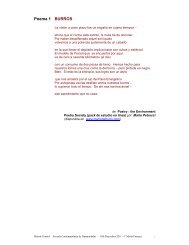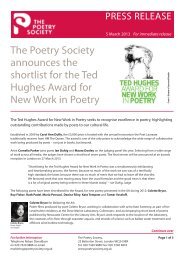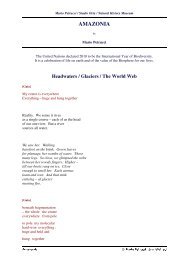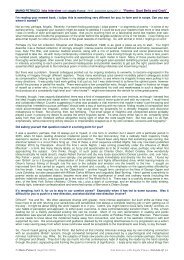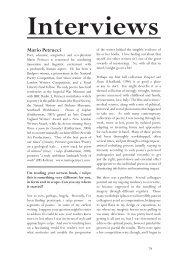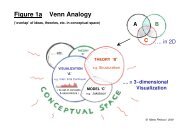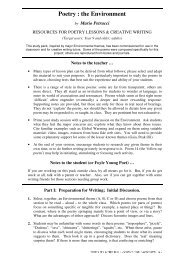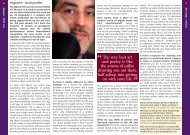Scientific Visualizations: Bridge-Building between ... - Mario Petrucci
Scientific Visualizations: Bridge-Building between ... - Mario Petrucci
Scientific Visualizations: Bridge-Building between ... - Mario Petrucci
Create successful ePaper yourself
Turn your PDF publications into a flip-book with our unique Google optimized e-Paper software.
SCIENTIFIC VISUALIZATIONS<br />
299<br />
extend that age-old undertaking in a multidisciplinary manner, guiding us<br />
away from any Procrustean dominion of models.<br />
Acknowledgements<br />
My thanks to the Royal Literary Fund for its generous support, to Howard<br />
Cattermole for his thoughtful comments, and to Rob Pope — the Venn mind<br />
without whom there would have been far fewer bubbles.<br />
Readers should note that the figures in this work are available to be viewed<br />
in colour online at www.ingentaconnect.com/content/maney/isr. The author<br />
retains copyright in all the figures presented in this paper.<br />
Notes<br />
1<br />
Having made (and, now, drawn) this distinction,<br />
I appreciate that in many teaching situations, the<br />
terms Visualization and visual analogy might be<br />
allowed to merge, at least initially. The visual<br />
forms presented in the figures are relatively new<br />
and their strength as <strong>Visualizations</strong> — to be<br />
frank — not yet fully established. The bulk of<br />
the science behind Figure 4, for instance, is not<br />
really present in Visualized form, meaning that<br />
the figure may be more akin to a diagram or flow<br />
chart. However, a weak degree of Visualization<br />
in an analogy is not necessarily detrimental to its<br />
worth or interest, and I do not wish to burden<br />
potential users with the feeling that any analogy<br />
they devise must also be a gilt-edged Visualization.<br />
That said, I invite fulsome challenge on the<br />
extent to which each of my examples actually<br />
does succeed as a Visualization.<br />
2<br />
In researching this paper, I did not systematically<br />
scour the annals of science hoping to find<br />
source <strong>Visualizations</strong> to apply to literary discourse.<br />
Often, the process entailed calling to<br />
mind — and attempting to Visualize — aspects<br />
of literary studies I sensed might possess correspondences<br />
with scientific subjects whose <strong>Visualizations</strong><br />
I already knew. On other occasions,<br />
the process was one of sudden insight — a cognitive<br />
leap that is, perhaps, somehow stored in<br />
the analogy itself and subsequently received by<br />
its user. What lies behind such leaps is, I<br />
suspect, some kind of simultaneity of conceptual<br />
traffic involving the relevant disciplines or<br />
topics. In much of this, I stabbed in the dark.<br />
Further research might offer a better-lit background<br />
against which future efforts could be<br />
launched.<br />
Bibliography<br />
Bohm, D. 1983. Wholeness and the implicate order. London: Ark/Routledge.<br />
Bohm, D. 1996. On dialogue, ed. Lee Nichol. London: Routledge.<br />
Bohm, D. 1998. On creativity, ed. Lee Nichol. London: Routledge.<br />
Bohm, D., and F.D. Peat. 2000. Science, order and creativity. 2nd ed. London: Routledge.<br />
Chalmers, D.J., R.M. French, and D. Hofstadter. 1991. High-level perception, representation, and analogy: A<br />
critique of artiÞcial intelligence methodology. Indiana University. http://consc.net/papers/highlevel.pdf.<br />
(01/04/2011)<br />
Cordle, D. 2005. Metaphor mongering: Science, writing and science writing. English Subject Centre<br />
Newsletter, issue 9, 5–9.<br />
Dawkins, R. 1976. The selÞsh gene. London: OUP.<br />
Gilbert, J.K., M. Reiner, and M. Nakhleh, eds. 2008. Visualization: Theory and practice in science education<br />
(Models and modeling in science education, vol. 3). London: Springer.<br />
Gould, S.J. 2004. The hedgehog, the fox, and the magister’s pox: Mending and minding the misconceived gap<br />
<strong>between</strong> science and the humanities. London: Vintage.<br />
Hofstadter, D. 2001. Analogy as the core of cognition. In The analogical mind: Perspectives from cognitive<br />
science, ed. D. Gentner, K. Holyoak, and B. Kokinov. Cambridge, MA: The MIT Press/Bradford Book.<br />
INTERDISCIPLINARY SCIENCE REVIEWS, Vol. 36 No. 4, December, 2011



